Anchoring & Mooring
With so much investment literally riding on your anchor, your boat's anchoring system is no place to cut corners. Your choice of anchor depends on the size and type of your boat, and the weather and anchoring conditions you generally encounter.
Boats with heavy displacements or superstructures that present a great deal of wind resistance need heavier gear. The same is true of cruising yachts that brave a wide variety of conditions and may sometimes have to anchor in open waters.
Although not required by Federal Law, it is recommended you carry one anchor of sufficient size and strength to hold your boat for an extended period, like overnight--or in an emergency situation, such as if you run out of gas. When you are thinking or buying an anchor - BIGGER IS BETTER.
Also, there is safety in numbers. No anchor will work for you in every situation, so if you have space carry two anchors--preferably of different types.Many people choose to carry a small anchor, or "lunch hook", and a larger working or storm anchor. The lunch hook is for use in calm weather and when the crew is monitoring the anchor. Working and storm anchors are useful at times when the crew is asleep or ashore, and during heavy weather, when winds are 30 miles an hour and over.
The general name for all of the equipment you need to anchor your boat is "ground tackle". This includes an anchor, chain, line and connecting elements. The anchor line, including chain, is called the rode.
Playing Hooky
Just as boats come in a wide variety of shapes and sizes, so do anchors. Choosing an anchor is easy, choosing the right one for your boat can be very difficult. Your first task in choosing an anchor is to have an understanding of three things:
- Your Boat - Your boats' size, weight and design characteristics affect what kind of anchor you will need to use. For instance, a 30 foot 10,000 pound houseboat needs a larger anchor than a 30 foot 6000 pound speedboat.
- Where You're Going - Where you plan to anchor often dictates what type of anchor you should use. Is the bottom rock, or is it soft mud? If you are not familiar with the area, ask around or look at a local chart.
- Local Conditions - Anchoring in a calm protected cove can be quite different than anchoring offshore or on a large open bay. And don't forget the weather--high winds, tides and waves can all make anchoring difficult, if not impossible.
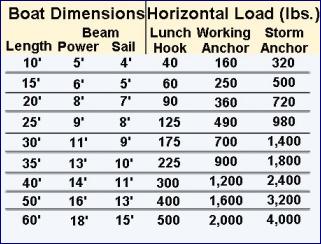
Anchors are rated by "holding power"--which is the ability of an anchor to hold a given weight. Keep in mind that a 10,000 pound boat may only require an anchor with a holding power of a few hundred pounds on a calm day, but may need 1,000 pounds of holding power or more on a stormy day.
Anchor Types
There are several types of anchors and you should choose a style based on the bottom characteristics in the areas you will anchor most often. Then, choose a size based on the size and weight of your boat.
Lightweight or "Danforth" Anchors
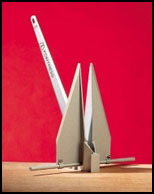
Lightweight type anchor with two long pivoting "flukes"; designed to reduce clogging with mud and grass; range from 2.5 pounds to nearly 200 pounds, and are generally made of cast galvanized metal, though some models are machined from a light-weight aluminum composite. When dropped, flukes dig the anchor into the bottom and the anchor buries itself and part of the anchor line.
Commonly used on small recreational boats, as they are relatively light weight for the amount of holding power they provide, especially in comparison to other anchors. Best in hard sand or mud, where flukes can easily dig into the bottom.
Not recommended for very soft or loose mud, which can ball up around the flukes; or on rocky bottoms where the flukes cannot penetrate. Also not recommended for grassy bottoms, which the flukes tend to slip off.
Kedge or Navy Anchors

A more traditional style anchor with arks, flukes and stock. Good in heavy grass, weeds, rocky bottoms or hard sand where one arm can penetrate a crevice. Not good in mud or loose sand, where flukes can't dig in.
Functions differently than previous anchors as it is not a burying anchor; one arm digs into bottom and one lies exposed. Generally only used by very large ships, as it relies on weight for most of the holding power; not really suitable for recreational use other than for a lunch hook.
Grapnels Anchors
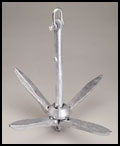
Very inexpensive, but not much holding power. Some models are made of bent re-bar, others are made of galvanized metal and have folding flukes. Good for recovering items on the bottom, or for wreck reef anchoring. Commonly used on very small boats such as canoes or jon boats.
Plow or "CQR/DELTA" Anchors

The plow styles' good holding power over a wide variety of bottom types makes it a top choice of cruising boaters. Has either a fixed (Delta style) or a pivoting (CQR) shank.
When dropped in the water, a plow lands on its side, then when pulled, buries itself. Its shape allows it to reset fairly easily should the wind or tide shift the boat position.
Great in sand and on rocky bottoms, weeds and grass. Does not do well in soft bottoms. Generally made of galvanized metal, though they are available in stainless steel.
Claw or "BRUCE" Anchors
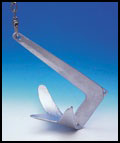
Unique shape of the claw allows a 360 degree turn without breaking out. Has similar performance to plow anchors,at a lower weight.
Sets just like a plow, but curved flukes make it easier for a claw to right itself no matter how it lands on the bottom, or how much the boat gets swung around.
Mushroom Anchors
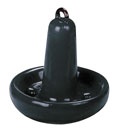
Mushroom anchors get their name from, as you might imagine, their rounded, mushroom shape. Mushroom anchors are used extensively for moorings, and can weigh several thousand pounds for this use.
The shape works best in soft bottoms, where it can create a suction that can be difficult to break. Decent for very small boats to use as a lunch hook, but not practical for larger boats. Both Buoys and Beacons may have lights attached, and may have a sound making device such as a gong, bell or horn. Both Buoys and Beacons may be called "marks".
Line and Gear
Depending upon the size and type of your boat, and where you anchor--your choices for an anchor line are either an all-rope anchor rode, a combination of rope and chain, or all chain.
Nylon Line in Three-Strand Twist
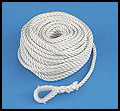
Three-strand line can absorb shock and the constant tugging associated with anchoring much better than braided line or chain alone. Chain may also be used, especially in anchorages that are primarily rock or coral, which may cut a nylon line. A length of chain should be used between the anchor and a longer length of line. The chain will add weight to set your anchor without making it too heavy to lift manually, while serving to exert a horizontal pull on the anchor to set it.
Nylon Three-Strand line is the leading choice for use as an anchoring line. Lines generally come in a "soft" or "medium" lie. Soft lines are generally softer to the touch, and loosely woven. These aren't as good as medium or hard lines for anchoring, as they are more prone to unraveling and chafing. Tightly wrapped lines are the best choice for anchoring.
Lines that have been treated with a wax-like coating are available. These lines help the line resist water/salt absorption. To help keep your lines in good shape, clean them from time to time by soaking them in soapy water. Never use bleach, as it can break down the line.
Chain

Chain may be used instead of nylon line for anchoring. Chain has several benefits, including added weight, chafe and wear resistance, and high strength. It also lowers the angle of pull on the anchor, which helps it to set more firn\mly into the bottom.
Chain is generally found made of galvanized steel, though you can find stainless steel and vinyl coated chain, which is designed to be non-marring to your deck.
Chain comes in three general varieties: "Proof Coil" is the most common, and is adequate for most marine uses. "BBB" ("Triple B" or "3B") chain has thicker, shorter links than proof chain. BBB is slightly stronger than proof chain, and is generally used for windlasses. Finally, "Hi-Test" chain is made of hardened steel, and is stronger and lighter than proof coil. Hi-test chain is favored by those wishing to avoid carrying too much weight.
Nylon Line in Three-Strand Twist
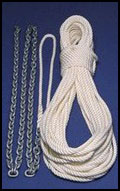
Combination anchor-rodes consist of both chain and nylon line. You may buy a combination rode, or you may make one yourself. Generally, it is recommended to have either one foot of chain for each foot of boat length, or to have one pound of chain for each pound of anchor length. Which ever method you choose, having more chain than necessary is never a bad idea.
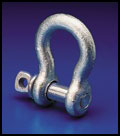
As the saying goes, a chain is only as strong as its' weakest link...Make sure that your anchor and line are attached to each other with adequate gear. Some lines come with plastic thimbles or eyes--but metal, either marine-grade stainless steel or hot-dipped galvanized steel, is best. Swivels and shackles should be inspected regularly for wear, and to ensure that the connections are tight and functional.
Scope
Scope: Length of the anchor line/ height of the deck cleat to the sea bed.
Before leaving the dock, you will need to determine how much anchor line, or "rode", you will need. It is recommended that you use a scope of 7:1, meaning that for every foot of water depth, you should use 7 feet of rode.

For example, to anchor in 10 feet of water, you would pay out 70 feet of line. Measure the scope as the ratio of the length of the anchor rode to the height of the bow above the bottom. If you're using a lightweight anchor on a small boat in good weather conditions, a shorter scope of 5:1 is sufficient and safe. A prudent boater always has extra line and chain on hand, just in case.
Minimum Working Rode Sizes
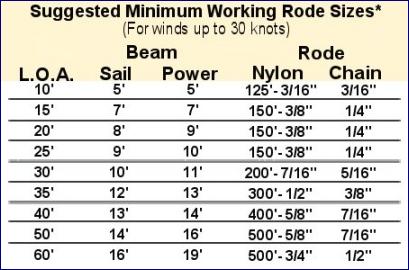
Suggested holding sizes assume fair holding ground, scope of at least 5:1 to 10:1, and moderate shelter from high seas.
Boats that operate generally in shallow waters, as on the East Coast of the United States, may get by with shorter rode lengths. As the wind picks up, deploying additional line will help maintain position, as will tossing out an extra anchor.
Setting Anchor
Anchoring can be accomplished quickly and easily by following a few simple steps.
- Check your chart for bottom characteristics and to determine that you are anchoring in a safe and allowable place. If there are rocks, shoals, reefs or other boats to consider, give them all as wide a berth as possible. Remember that other boats will often have different requirements for anchor rode length--larger or taller boats frequently need a great deal of rode. Also, keep in mind a possible swing of 360 degrees about the anchor with wind shifts or current changes.
- If your crew is not already wearing PFDs, have them put one on before going forward to set or retrieve an anchor or mooring.
- Secure the bitter end of the anchor line to a bow cleat. Make sure the line is ready to run free once tossed overboard.
- Head into the wind or current. Reduce speed and reverse the engine. When the boat starts to make a slight sternway through the water, lower - do not throw - the anchor.
- After you've let about a third of your line out, tug the anchor line to see how firmly it's set, and then continue to release the rode.
- Once you let out an appropriate amount of scope, make sure the line is properly tied off on the bow cleat.
- Even if anchoring only in designated anchoring areas, it is always prudent to have the appropriate signal such as an all-around white light on to notify other boats that you are anchored at night. During the day you must display a ball shape which is sized according to the size of your boat.
Staying Put
It's a good idea to take two immediate bearings. Select two items, one off each beam, that form a natural range and watch for any changes in their relationship. You can check these later to determine if you're boat is swinging as expected or if you're dragging anchor.
Picking Up a Mooring
One of the best ways to avoid the hassles of anchoring is to chose a cove or harbor with moorings available for your use. Mooring balls are identified by their white spherical or can shape, and having a blue horizontal band. It may have a number designation, a VHF contact # or name on it. You will typically have to pay a small fee to the harbor master to use a public mooring, but you can count on it being far cheaper than paying for dockage for the night.
Public moorings are professionally maintained and will use a large anchor or helix screw fixture to maintain position. The harbor master will let you know if the weight or length of your boat is too big for that particular mooring. Although moorings are typically more secure than anchors, moorings can and do periodically give way. For this reason, and for the obvious courtesy reasons, you should never pick up and use a mooring that does not belong to you.
Lines that have been treated with a wax-like coating are available. These lines help the line resist water/salt absorption. To help keep your lines in good shape, clean them from time to time by soaking them in soapy water. Never use bleach, as it can break down the line.
WATCH OUT
Common Anchoring Mistakes
- Letting the anchor go with out securing the line to the boat.
- Letting the anchor go with your foot wrapped in the anchor line.
- Poor communication between the captain and person on the foredeck.
Picking Up a Mooring
- Approach a mooring from downwind. This will give you better maneuverability as you go to secure your boat to the ball.
- Go slow, so as not to disturb those already moored.
- After putting on PFDs, send a crew member to the bow with a boat hook to grab the eye or the base of the mooring ball.
- Once the mooring ball is at the bow--slow, stop or gently reverse engines to halt forward motion. Use your crew to relay distance information if it is difficult for the skipper to see where the mooring ball is in relation to the boat.
- Loop the mooring line over one or both of your bow cleats. Pay attention to the possibility of chafing. You may want to use your own line to attach to the mooring ball if the one provided is dirty.
- Some moorings may have an antenna like device called 'whip.' This is simply an extension of the ball so you don't have to reach as far to haul in the mooring line.
- Once secure, let the boat drift back and be sure that you are clear of those who have moored or anchored around you. There is no need to 'back down' on a mooring ball.
- Leaving a mooring is easy--just motor or pull up gently to the ball and release the mooring line from your boat. You can then either drift back or maneuver forward to clear yourself of the ball and the associated ground tackle.
Finally, never ever anchor a small boat by the stern! Your engine, and the bulk of the boat's weight rest here. Stern anchoring is likely to result in swamping and flooding.

